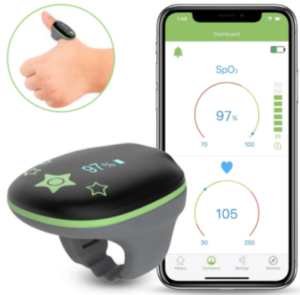Сhildren Pulse oximetry is a technique for measuring heart rate, blood saturation, and pulse wave amplitude in children.
This is a non-invasive examination that is performed using a pulse oximeter.
Looking for the best pulse oximeter for children?
In my opinion, The Top Pulse Oximeter for children may be Wellue KidsO2, it is the best choice for children. It is a great device for children because it is not slippery and a child can not simply lose the ring. It has free software and you can share the child’s reports with doctor PDF/CSV analysis reports easily.
Table of Contents
Normal oxygen saturation by age child
Saturation rates for adults and children are the same.
If you see a deterioration in a child’s illness – rapid breathing, lethargy, pallor of the skin, inappropriate behavior, high temperature that does not go astray, then it would be a must to measure the oxygen content in the blood immediately.
Can you use a pulse oximeter for a child?
Yes. There are many pulse oximeters for children. To choose the best one click HERE…
A pulse oximeter for children differs from an adult in the size or design of the sensor.
In the standard version, the device has the form of a clothespin, in the children’s version – a silicone or rubber fingertip, which does not compress the vessels when it is on the arm for a long time…
It is an affordable and accurate device for checking heart rate and blood oxygen saturation levels. The device is suitable for children from 1 to 12 years old.
Models of pulse oximeters are designed for children of different ages. On sale there are devices for children weighing less than 2 kg.
In such cases, the baby’s foot is used – it will not be possible to properly fix the device on the finger.
When used correctly, neonatal devices allow you to control the vital functions of the body. This is especially important for premature babies, as well as in the presence of developmental pathologies.
What are pulse oximeters for children and how do they differ from adult models?
Now you can see different models of children’s pulse oximeters, which differ from adult models in size, design (for children these are brighter devices).
However, they have the same principle of operation: a sensor with infrared radiation is in every device. It passes through the skin, soft tissues of the finger, earlobe or foot and is absorbed into the blood. The device displays heart rate and SPO2 depending on how oxygenated the blood is. Most household pulse oximeters run on batteries.
Looking for the best pulse oximeter for you?
I believe the Wellue O2 Ring is the best choice for overnight oxygen saturation monitoring.
I would recommend choosing the Wellue O2 Ring . I think it is the latest technology of pulse oximeters.
It is the best choice for overnight oxygen saturation monitoring and health monitoring.
How is saturation measured in children?
To measure saturation, the diode emits light, so that the finger is completely translucent, the amount of saturated hemoglobin is analyzed.
That is, the device displays the average amount of oxygen added to hemoglobin and shows the result as a percentage. The procedure takes a few seconds.
 Normal Oxygen Saturation By Age Child
Normal Oxygen Saturation By Age Child
As a rule, the first indicator on the screen is the pulse, respectively, the second is saturation. During the coronavirus pandemic, it is the second indicator that is most often controlled. This allows you to quickly take action and understand what condition the child is in.
If the mother has a portable pulse oximeter at her disposal, she can independently monitor the condition of the child, even if there are no symptoms of diseases. Given the recent events related to the coronavirus, this device in the house is no less important than a thermometer or a first aid kit.
Oxygen Levels in Children Chart
| Age | Heart rate norms | Saturation Level |
| Newborns – 2 years | 110-180 | All patients must have an (SpO2) of 95% or greater. |
| 2-10 ages | 70-140 | All patients must have an (SpO2) of 95% or greater. |
| 10 and more | 60-90 | All patients must have an (SpO2) of 95% or greater. |
What if the oxygen level is too low for a child?
What should be done if a child’s saturation drops immediately?
In all cases where the child has a low saturation level (SpO2<95%), it is necessary to increase the volume of inhaled oxygen and act according to the ABCDE scheme:
– A – are the airways (AIRWAY) passable? Ensure the patency of the upper respiratory tract, check the position of the ETT (if any), and stop laryngospasm when it develops.
– B – breathing (BREATHING) is present? Check respiratory rate, check tidal volume, auscultate the lungs, check for bronchospasm (stop with bronchodilators).
– С – blood circulation (CIRCULATION) is normal? Check pulse, check blood pressure, check ECG, check for blood loss, dehydration (if necessary – infusion therapy).
– D – the impact of (DRUG EFFECTS) is not the cause? Opioids, volatile anesthetics, sedatives, muscle relaxants.
– E – equipment (EQUIPMENT) works correctly? Check the oxygen supply, check the tightness and patency of the breathing circuit…
How to behave if the saturation level of children drops?
| The saturation level | What to do? |
| 90% or
less |
Extremely dangerous levels of oxygen saturation of the blood indicate a serious health disorder. Call immediately the ambulance
They may require emergency x-ray or cardiac study |
| 91% to 94% | Dangerous blood saturation level oxygen, may indicate health disorder. Immediately
call your doctor or you can contact nearest emergency room. |
| 95-100% | Normal blood saturation level oxygen. Let the child walk around for two
minutes and measure the saturation level blood with oxygen again. If the level blood oxygen saturation will drop below 95%, follow the instructions above. |
When to get a children pulse oximeter?

The number of children suffering from various types of chronic diseases is growing.
Some diseases are directly related to the lack of oxygen in the blood. The study is aimed at determining the heart rate and saturation. Normally, in children, the saturation should be over 95%. At a value below this indicator, there is a problem in the form of hypoxia. If in adults the number of heartbeats at rest is 60-90 beats per minute, then in children there are age norms and at an earlier age the heart rate is higher. The device is used in the following cases:
- If there is a suspicion of respiratory failure;
- During surgery;
- During oxygen therapy;
- Prolonged general anesthesia;
- Increased drowsiness;
- Anemia;
- Disorders in the work of the lungs;
- Blood circulation disorders;
- Pneumonia;
- Bronchial asthma;
- Heart disease.
Recommendations of pulse oximeters for children from 3-10?
Home appliances, designed for ages 3 to 10, will be great helpers for parents whose children suffer from sleep apnea or chronic nocturnal hypoxemia.
A child, sleeping peacefully in his crib, may not even notice how measurements are taken. With a quiet, portable home device, you can perform all the necessary measurements to track the dynamics of the development of the disease and the effectiveness of the treatment prescribed by doctors.
FAQ
Can an adult pulse oximeter be used on children?
Adult pulse oximeters are not suitable for reading saturation in children…
What is the Normal Oxygen Level of newborns?
The saturation level in a normal newborn in the first hours of life is 88% or more…
What is a Normal oxygen level for a 4, 5, or 6-year old?
Normal blood oxygen saturation is between 97-99% for most kids
What is a normal oxygen level for 10-year?
It is considered important be a 95 to 100 percent oxygen level in a 10 child’s body

